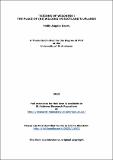Files in this item
'Visions of wildness' : the place of (re)wilding in Scotland’s uplands
Item metadata
| dc.contributor.advisor | Warren, Charles | |
| dc.contributor.advisor | McMorran, Rob | |
| dc.contributor.author | Deary, Holly Angela | |
| dc.coverage.spatial | xi, 385 p. | en_US |
| dc.date.accessioned | 2017-10-23T13:15:46Z | |
| dc.date.available | 2017-10-23T13:15:46Z | |
| dc.date.issued | 2014-07 | |
| dc.identifier.uri | https://hdl.handle.net/10023/11903 | |
| dc.description.abstract | Notions of ‘wildness’ are increasingly relevant to upland management discussions in the Scottish Highlands as several conservation-focused estates embrace a ‘wildland management ethos’. However, while a range of wildland conservation initiatives have embarked upon pathways towards ‘rewilding’, this research demonstrates that, although members of this creative conservation movement are widely perceived to share a common vision, they prioritise markedly different wildland qualities. Through a series of triangulated phases, this research explores this ‘spectrum of wildness’ and examines the conceptual coherence of wildland restoration discourses. Twenty semi-structured scoping interviews with key stakeholders associated with Scotland’s wildest places provide the foundations for an adapted Delphi model, incorporating a Q-methodology study, which utilises insights from seventeen large upland land-holdings to interrogate the disparate discourses associated with Scotland’s emergent wildland movement. A taxonomy of management approaches is presented based upon (i) different conceptions of ‘wildness’, (ii) differing degrees of concern for ecological and cultural integrity, (iii) conflicting beliefs about the degree of management intervention appropriate and (iv) fundamentally divergent underlying environmental ideologies. A further twenty-three semi-structured interviews exploring wilderness restoration frameworks in the USA, New Zealand and parts of Europe provide an international perspective on Scotland’s distinctive approach to wildland management and demonstrate the challenges of multi-dimensional wilderness frameworks which grow out of conflicting mandates; most notably, a critical faultline exists between restoring ‘wildness’ (focussed on processes) and naturalness (focussed on endpoints). Given that practical tensions can arise from these different ideological perspectives, understanding and accommodating the social and cultural dimensions which shape multiple (re)wilding discourses is considered critical. As such, place-specific and endogenous social representations are called for, in which wild land is both a physical place and a cultural ideal, and in which (re)wilding comprises a heterogeneous mix of different wilds. This research also critically reflects upon how cultural landscapes with wild qualities present opportunities for rethinking the historical and cultural dimensions of established wilderness values. By exploring the framing of ‘wild’ in Scotland’s wildland initiatives, a postmodern wildlands narrative which negotiates the conceptual challenges of (re)wilding in a storied, cultural landscape is presented. | en_US |
| dc.language.iso | en | en_US |
| dc.publisher | University of St Andrews | |
| dc.subject.lcc | QL83.4D42 | |
| dc.subject.lcsh | Wildlife reintroduction. | en |
| dc.subject.lcsh | Wildlife conservation--Great Britain. | en |
| dc.subject.lcsh | Ecosystem management--Great Britain. | en |
| dc.subject.lcsh | Uplands--Scotland. | en |
| dc.title | 'Visions of wildness' : the place of (re)wilding in Scotland’s uplands | en_US |
| dc.type | Thesis | en_US |
| dc.contributor.sponsor | Carnegie Trust for the Universities of Scotland | en_US |
| dc.type.qualificationlevel | Doctoral | en_US |
| dc.type.qualificationname | PhD Doctor of Philosophy | en_US |
| dc.publisher.institution | The University of St Andrews | en_US |
This item appears in the following Collection(s)
Items in the St Andrews Research Repository are protected by copyright, with all rights reserved, unless otherwise indicated.

